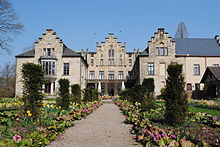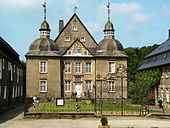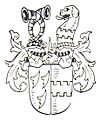Bussche (noble family)
Von dem Bussche is the name of an ancient noble family from the Ravensberger Land in East Westphalia , which was first mentioned in 1225. In the late Middle Ages it also acquired property in the neighboring bishopric of Osnabrück , which it largely holds today. It was divided into three main lines and several secondary branches and later acquired property in other regions, such as Anhalt, the Harz and the Sauerland.
history
origin
The family was first mentioned in a document in 1225 with the dominus ( lat. Lord) Everhardus de Busche . His brother Albert is mentioned in documents from 1230. The uninterrupted line of trunks begins with an Albert who appears from 1341 . The key name Albert was given to members of the family for a long time.
The gender is to be distinguished from the same name but not related sexes from neighboring regions.
The Lords of the Bussche originally sat in the Ravensberg area or in the border area between the Grafschaft Ravensberg and the bishopric of Osnabrück . As early as 1390 they were able to acquire the Osnabrück Castle Ippenburg and in 1447 also the neighboring Hünnefeld Castle , both to the east of Osnabrück (Lower Saxony). In the first half of the 16th century Lohe (municipality of Bakum ) came to the north Munster district of Vechta , and at the beginning of the 17th century Haddenhausen near Minden , 1656 Streithorst (northeast of Osnabrück) and 1820 Schloss Neuenhof near Lüdenscheid in Sauerland and the Dötzingen estate in Hitzacker (Elbe) (Lower Saxony) in family ownership. With the exception of Lohe, these goods have remained in the possession of the Counts and Barons von dem Bussche to this day. After the Reformation, the family converted to the Protestant denomination.
Lines and status surveys
Gerhard-Clamor and his wife Anna, b. von Ascheberg , are the first parents of all Bussches living today. Their estates Ippenburg, Lohe and Hünnefeld were divided between the sons in 1598, creating the three main lines of the family. They made the names of their ancestral homes to nickname: Bussche- Ippenburg to branch called Bussche Münch (1773), Bussche- Lohe to the branch line Bussche-Haddenhausen and Bussche- Hünnefeld with the branch Bussche- Streithorst .
After individual lines had already received confirmation of the use of the customary baron title , the baron status of the Kingdom of Prussia was confirmed in 1884 for all branches of the family . Individual representatives of the family were also raised to the rank of count.

Bussche-Ippenburg
Ippenburg Castle in the district of Osnabrück (Lower Saxony) has been owned by the family since 1390 until today. The castle from the end of the 14th century was demolished in 1811; the baroque manor house built north of it after the Thirty Years War was demolished in 1862 and replaced by today's neo-Gothic castle from 1862. The Ippenburg manor is still managed by the Barons von dem Bussche-Ippenburg.
Alfred von dem Bussche-Ippenburg , royal Prussian director -assessor , received the Prussian approval to use the title of baron in 1846.
After 1918, a branch of the Ippenburg line inherited the Dötzingen manor in Hitzacker (Elbe) (Lower Saxony) from the Counts of Oeynhausen ; through the marriage of Gabriele Freiin von dem Bussche-Ippenburg (1877–1973) with Georg Freiherr von dem Bussche-Haddenhausen (1869–1923) Dötzingen passed to their son Julius von dem Bussche-Haddenhausen (and thus to the Haddenhauser line) who still owns the estate. Julius' sister was Gösta Freiin von dem Bussche-Haddenhausen (1902-1996), the mother of Claus von Amsberg , who later became Prince Consort of the Netherlands, who grew up partly in Dötzingen.

- Bussche-Ippenburg called von Kessel
Julius von dem Bussche-Ippenburg , adopted von Bottlenberg called Kessel , received the Prussian name and coat of arms association with the extinct lords of the Bottlenberg called Kessel on May 3, 1825and becamea count on October 15, 1840 in the Prussian primogenic count raised by the Bussche-Ippenburg called von Kessel . From the legacy of the Bottlenberg-Kessel family, Neuenhof Castle near Lüdenscheid in the Sauerland (North Rhine-Westphalia) with Hackhausen Castle (sold in 1891) was owned by the family; Neuenhof is nowinhabitedby Alhard Graf von dem Bussche-Kessell . His son Philip Freiherr von dem Bussche-Ippenburg owns the Ippenburg estate.
- Bussche-Münch
Philipp Clamor von dem Bussche-Ippenburg (1728-1808), cathedral capitular of Osnabrück and universal heir to the Brunswick-Lüneburg landdrosten Philipp von Münch at Benkhausen Castle and the Werburg house , received the Prussian name and coat of arms association with those of Münch under on June 10, 1773 the name of the Bussche called Münch . In 1875 the branch died out, the heir from the Ippenburg branch took the name Karl von dem Bussche-Münch (with Prussian approval from 1886). His only son Alhard (* 1897) had no children and sold Werburg in 1941 and Benkhausen in 1962.
Bussche Lohe
- Tan
The line had been based on Gut Lohe (today a district of Bakum in Oldenburger Münsterland in Lower Saxony, northeast of Osnabrück) since the first half of the 16th century . It continues to bloom today. The moated castle Lohe from the beginning of the 14th century was sold for demolition in 1828.

In the middle of the 16th century, the Lohe line inherited the Cösitz estate in the Principality of Anhalt-Köthen (now Saxony-Anhalt) and relocated its headquarters there. Cösitz remained in the possession of the Barons von dem Bussche-Lohe until the expropriation in 1945.
In 1728 Johann Clamer von dem Bussche-Lohe inherited the former Walbeck monastery in the Harz Mountains, where his heirs built Walbeck Castle in 1765 ; it remained in the line's possession until the end of the 19th century. In 1768, the Bussche-Lohe also acquired the Rethmar Castle near Hanover from the related barons of Hardenberg and owned it until 1850.

- Haddenhausen
In 1610 Johann von dem Bussche-Lohe acquired the Haddenhausen estate near Minden (North Rhine-Westphalia) from his father-in-law Hilmar the Elder. J. von Münchhausen , who had to sell it as the guardian of his nephews. The married couple Johann and Hedwig von dem Bussche had Haddenhausen Castle built in the Weser Renaissance style between 1613 and 1616 . The manor and castle are still owned by a family foundation, which was founded on March 1, 1690 by District Administrator Christoph von dem Bussche-Hünnefeld from the Bussche-Hünnefeld family foundation .
Kuno von dem Bussche-Lohe received on July 16, 1868 Prussian approval to use the title of baron and the nickname Haddenhausen . One member of the branch, General Ludwig von dem Bussche , owned the Hanoverian Gut Liethe from 1817 , another, Hilmar von dem Bussche-Haddenhausen , owned Gut Katelbogen in Mecklenburg from 1936 to 1945 . One branch is based in Dötzingen today.
- Gentlemen on Haddenhausen

- Johann von dem Bussche-Haddenausen-Lohe (1570–1624), Lord of Lohe, bought the Haddenhausen manor in 1609
- Hilmar von dem Bussche-Haddenhausen-Lohe (1617–1677), Lord of Haddenhausen, Johann's 2nd son
- Johann Wilken von dem Bussche-Haddenhausen (1652–1705), Lord of Haddenhausen, Drost of Hausberge and Councilor of Minden
- Hilmer Albrecht von dem Bussche-Haddenhausen (1689–1726), Lord of Haddenhausen, Go. Government councilor and cathedral sexton of Minden, transferred the Haddenhausen manor in 1708 to von dem Bussche-Hünnefeld's ancestral legacy
- Hilmer Freiherr von dem Bussche-Haddenhausen (1867–1936), German diplomat

Bussche-Hünnefeld
Hünnefeld Castle came into the possession of Albert von dem Bussche in 1447. The current mansion was built in 1600 by Gerhard-Clamor von dem Bussche and his wife Hedwig, née. von Münchhausen, the southern side wing was added in 1658 by their son Clamor-Eberhard. The line of barons von dem Bussche-Hünnefeld is still owned by the Hünnefeld manor today.
The eldest son of Clamor Eberhard, Christoph (* 1643) acquired the Buddemühle estate in Wehrendorf and donated the cathedral patrons to Minden and Halberstadt . He also set up a family foundation, the so-called Hünnefelder Stammlegat with starting capital of 100,000 gold talers, which has been responsible for supporting and promoting members of the von dem Bussche family for over 300 years until today.
The royal Westphalian ambassador in Saint Petersburg , Clamor Dietrich Ernst Gerhard von dem Bussche-Hünnefeld , was elevated to the Westphalian count on January 23, 1810; however, the count's branch is extinguished.
- Bussche-Streithorst
Clamor Eberhard (* 1611), Herr zu Hünnefeld, bought the Streithorst manor in the Osnabrück region in 1656 , which his youngest son Johann Heinrich, who founded the Streithorster Zweig, took over. His grandson Clamor Eberhard († 1753) founded the Majorat Streithorst, which consisted of Streithorst, Schwege, Wechmannshoff and Derenburg.

His son Ernst August bought additional goods, especially in 1755 Thale in the Harz (Saxony-Anhalt) with the former Wendhusen monastery ; Thale was run as the manor "Wendhusen I", the monastery property that resulted from the monastery as "Wendhusen II"; both remained in the family's possession until the expropriation in 1945. The resistance fighter Axel von dem Bussche (1919-1993) came from this branch.
It was not until Georg Clamor Carl Maximilian Traugott († 1896) changed his name from Bussche-Hünnefeld to Bussche-Streithorst , which resulted in a new line. Axel Ernst-August Clamor sold the eponymous manor Streithorst after the death of his father Georg Clamor and his stepmother Auguste in 1977. It was not until 2004 that the Streithorst manor came back into family ownership when Eberhard Clamor, a member of the second house of the Hünnefelder line, acquired. Eberhard Clamor carried out extensive renovations before he could live in it again.
- Gentlemen on Streithorst
- Clamor Eberhard Freiherr von dem Bussche-Hünnefeld (1611–1666), Lord of Hünnefeld and Streithorst (since 1656)
- Johann Heinrich Freiherr von dem Bussche-Hünnefeld (1644–1689), Lord of Streithorst, bought Meinbrexen in 1678, Staue and Oldendorf in 1684
- Clamor Eberhard Freiherr von dem Bussche-Hünnefeld (1683–1753), Lord of Streithorst, Schwege and Wechmannshoff
- Ernst August Freiherr von dem Bussche-Hünnefeld (1719–1796), Majorate Lord of Streithorst, childless
- Werner Ludwig Clamor Freiherr von dem Bussche-Hünnefeld (1748–1816), son of Ernst August's brother Johann Friedrich, cathedral senior and provost of Halberstadt, took over as majorate of Streithorst, childless
- August Clamor Friedrich Wilhelm Freiherr von dem Bussche-Hünnefeld (1776–1831), Lord of Stecklenberg , Canon of Magdeburg; Son of Werner Ludwig Clamor's brother Christian August Clamor, took over as lord of Streithorst, Thale and Steinhausen
- Georg Clamor Carl Maximilian Traugott Freiherr von dem Bussche-Streithorst (1825–1896), Majorate Lord of Streihorst and Thale , etc., member of the Prussian manor house; changed the name of the line to Streithorst
- Cuno Clamor Carl Georg Friedrich Freiherr von dem Bussche-Streithorst (1850–1907), Majorate Lord on Streithorst, Thale etc.
- Georg Clamor Lothar Albert Hans Hilmat Louis Freiherr von dem Bussche-Streithorst (1883–1959), Majorate Lord of Streithorst, Thale etc.
- Eberhard Clamor Dieter Manfred Freiherr von dem Bussche-Hünnefeld (* 1961)
coat of arms
The family coat of arms (oldest seal from 1341) shows in silver three (2: 1) red plowshares swept right with the edges . On the helmet with red-silver covers two slanted silver hunting horns , each with three (or five) red ribbons wrapped around with the sound openings upwards and outwards (medieval shape: Hifthorn ).
The coat of arms of those from the Bussche-Ippenburg called von Kessel is split. On the right it is like the family coat of arms with plowshares swept to the left, on the right like the coat of arms of Bottlenberg called Kessel: In silver a dead bar tinned four times above and three times below.
The coat of arms of those von dem Bussche-Münch is quartered; fields 1 and 4 correspond to the family coat of arms, 2 and 3 in silver with the Saxons (wing bones) inward-facing red wings.
Known family members
- Lebrecht von dem Bussche (1666–1715), Russian major general and governor of Riga
- Ernst August Philipp von dem Bussche-Ippenburg (1681–1761), general of the cavalry and governor of Hameln
- Karl Leberecht von dem Bussche (1707–1782), Prussian colonel
- Georg Wilhelm von dem Bussche-Haddenhausen (1726–1794), general, died on the Waal
- Wilhelm Christian von dem Bussche (1756–1817), German landowner and governor
- Ludwig August Friedrich von dem Bussche-Haddenhausen (1772–1852), general, son of Georg Wilhelm
- Hans Clamor Hilmar von dem Bussche (1774–1851), Hanoverian general of the infantry, son of Georg Wilhelm
- Georg von dem Bussche gen. Von Münch (1791–1874), German government official and district administrator
- Friedrich von dem Bussche-Ippenburg (1791–1869), Prussian lieutenant general
- Theodor von dem Bussche -Lohe (1791–1855), German lawyer, court official and theater manager
- Count Julius von dem Bussche-Ippenburg called von Kessell (1805–1861), German administrative lawyer, Prussian district administrator and politician
- Bernhard von dem Bussche-Haddenhausen (1823-1894), Prussian lieutenant general
- Georg von dem Bussche-Streithorst (1825–1896), Prussian landowner and member of the Prussian manor house
- Count Wilhelm von dem Bussche-Ippenburg called von Kessell (1830–1897), German manor owner and member of parliament
- Karl von dem Bussche-Münch (1861–1900), German manor owner and member of parliament
- Hilmar von dem Bussche-Haddenhausen (1867–1939), German diplomat
- Count Hermann von dem Bussche-Ippenburg called von Kessell (1869–1943), landowner and member of the Prussian manor house
- Erich von dem Bussche-Ippenburg (1878–1957), German general of the artillery
- Gösta von dem Bussche-Haddenhausen (1902–1996), mother of Claus von Amsberg , prince consort of Queen Beatrix of the Netherlands
- Julius von dem Bussche-Haddenhausen (1906–1977), landowner and politician, brother of Gosta von dem Bussche-Haddenhausen
- Axel von dem Bussche (1919–1993), German officer and resistance fighter July 20, 1944
- Albrecht von dem Bussche-Ippenburg (1921-2005), landowner
- Alhard Graf von dem Bussche-Kessell (* 1947), German entrepreneur
- Philip Freiherr von dem Bussche (* 1950), farmer and 1996 to 2005 President of the German Agricultural Society (DLG)
- Viktoria Freifrau von dem Bussche (* 1953), German author
See also
literature
- Gustav von dem Busche: History of the von dem Busche . Regest and documents, digitized
- Anton Fahne : History of the Westphalian families. P. 423 ( Bussche pedigree in the Google book search).
- Genealogical manual of the nobility . Nobility Lexicon. Volume II. Volume 58 of the complete series. CA Starke Publishing House. Limburg (Lahn) 1974. ISSN 0435-2408 .
- Otto Hupp : Munich Calendar 1931. Buch u. Art Print AG. Munich / Regensburg 1931.
- Günter Laue: The von dem Bussche family and the Buschhof, one of the "Sieben Höfe". Article about the families of Bussche and de Wendt in Lemgo
- Kurt Mantel : Bussche, from him. In: New German Biography (NDB). Volume 3, Duncker & Humblot, Berlin 1957, ISBN 3-428-00184-2 , p. 73 ( digitized version ).
- Gothaisches genealogical pocket book of baronial houses 1876 p. 98ff , 1892 p.114ff
- Gothaisches genealogical pocket book of the count's houses 1875. S. 158f Bussche-Ippenburg called von Kessel
Web links
- Entry about Bussche in New General German Nobility Lexicon
- Entry about Bussche in New Prussian Adelslexicon
- Search for the “Bussche noble family” in the German Digital Library
- Search for the “Bussche noble family” in the SPK digital portal of the Prussian Cultural Heritage Foundation
Individual evidence
- ↑ Westfälisches Urkundenbuch 3 (1868), No. 1712.
- ↑ For example For example, the bushes (with the lily coat of arms ) from the county of Schaumburg are neither a tribal nor a coat of arms-like nobility, which went out in 1565 with Klaus Büschen in Hessisch Oldendorf (later the Münchhausenhof ) and to which the humanist Hermann von dem Busche also belonged.
- ↑ Otto Gruber: The coats of arms of the South Oldenburg nobility . In: Yearbook for the Oldenburger Münsterland 1971 . Vechta 1970, p. 17f.
Coordinates: 52 ° 20 ′ 23.2 " N , 8 ° 21 ′ 41.3" E





